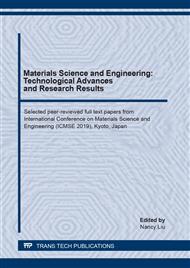p.3
p.10
p.18
p.24
p.31
p.39
p.47
p.57
Effects of Minor Elements Additions to the Nanocrystalline FeAl Alloy Produced by Powder Metallurgy
Abstract:
Mechanical alloying has recently attracted considerable attention as researchers try to improve materials properties. The process can be performed at room temperature and homogeneous alloys can be produced. In this work Fe–28 wt. % Al; Fe–26 wt. % Al–2 wt. % Sn and Fe–26 wt. % Al–2 wt. % V alloys were synthesized by mechanical alloying to investigate the effects of tin and vanadium additions on the structural and microstructural properties of Nanocrystalline FeAl Alloy. Fe72Al28, Fe72Al26Sn2 and Fe72Al26Sn2 were ball milled for 30 h under argon atmosphere using a rotating speed of 200 rpm with 15 min pause time after every 15 min running time. The structural and microstructural properties of the ball milled powders were analyzed using X-ray diffraction (DRX) and Mössbauer spectroscopy techniques. The final powders are characterized by an average crystallite size of 10 nm for the Fe72Al28 alloy, 6 nm for the Fe72Al26Sn2 alloy and 19 nm for the Fe72Al26V2, accompanied by the introduction of a lattice strain of order of 1.55 %, 0.78 % and 0.80% respectively. The Mossbauer study of the Fe72Al26V2 samples showed doublet with isomer shift IS= 0.17 mm/s and three magnetically split sextet.
Info:
Periodical:
Pages:
3-9
Citation:
Online since:
August 2020
Authors:
Price:
Сopyright:
© 2020 Trans Tech Publications Ltd. All Rights Reserved
Share:
Citation:


